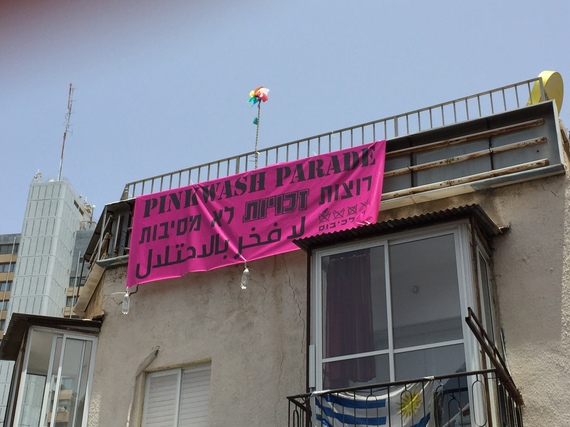Cognitive dissonance is described as the mental discomfort experienced by an individual who holds two or more contradictory beliefs, ideas or values at the same time. It's analogous to the gender dysphoria suffered by many trans persons when their innate biological sense of self doesn't match the gender they were assigned at birth and in which they were raised. I believe it can also be extended to larger population groups, which, in an age of growing extremism on both the right and left, feel forced to hold two (or more) seemingly contradictory ideological beliefs about different aspects of society. The cognitive dysphoria is created by the extremists, on both the right and left, for political purposes; there is no inherent reason there should be a problem in the first place, as the ideas are often independent concepts. When you define your terms clearly the problems dissolve.
Exhibit A is the issue of pinkwashing, or pinklying, about which I've written extensively this year. Israel's Pride Week this year has, once more, enabled the concept to flourish. I participated in the recently concluded historic Jewish Federations of North America (JFNA) LGBTQ mission to Israel, successfully led by Stuart Kurlander. The first such mission in eleven years, and the largest ever, the journey was filled with events to match its historic nature. We were invited to meet President Rivlin, at his residence in Jerusalem, and U.S. Ambassador Shapiro at his in Herziliya. The visit was covered by major Israeli media, from Haaretz to the Times of Israel. We visited projects supported by the JFNA, from the Kadoorie Agricultural High School in the Galilee; NGT3, the only tech incubator in the country which includes Israeli Palestinians, in Nazareth; Yevulim Ecological Farm, an agricultural school for the developmentally delayed, in Hod haSharon; and visits with Palestinians, such as Ali Abu Awaad of Shorashim, and excursions highlighting the security situation - within Israel proper, the West Bank and East Jerusalem, and the surrounding battlefields.
Those stops were interspersed with visits to the local LGBTQ community, including the LGBTQ Jerusalem Open House, and the LGBTQ community center in Gan Meir in Tel-Aviv, home to many gay and trans organizations in the region, including IGY, Israel Gay Youth; Ma'avarim, the trans political group; and Gila, the trans social outreach group. We also visited Beit D'ror in Tel-Aviv which houses primarily homeless trans persons, and is mostly government funded. Early in the week some of us spent Thursday evening in Zion Square in Jerusalem, participating in the weekly "Meeting Place" initiative led by Sarah Weil where the local LGBT population meets to remember Sarah Banki, who was murdered during last year's Pride parade, build community, and meet with those opposed to equality, face-to-face.
I would also like to note that while the gay community in Israel politically supports the trans community, it is the trans community, with very little money, that takes care of its own. They work ceaselessly and selflessly with little financial support, and deal with their own problems of intersectionality, sex work, domestic abuse, housing, bureaucracy, and providing therapy and social work within some very challenging situations. Remarkably, the prevalence of HIV in the trans population mirrors that in the general population, unlike in the U.S.
This mission was not a political mission -- the mission was composed of modern orthodox and secular, left-wing, right-wing and center, Jews and non-Jews. The only commonality was LGBTQ identity (I was the only openly trans person), which leads me to an important point -- it is that commonality that can, and often does, function as a bridge across the diverse spectrum of Israeli ethnicities and identities. It might seem very strange, and it certainly feels strange on occasion, that sexual minorities can be a bridge among highly different cultures. But when you are a gay Palestinian in Ramallah or a trans haredi (ultra-orthodox) in Jerusalem, you find that it is your sexual minority status and experienced oppression that brings you together and then allows mutual respect to grow. That is the positive side of community, or kehila. Its negative manifestation was most visible in opposition to LGBT Pride in Jerusalem in 2005, when the leaders of Jerusalem's religious communities -- Eastern Orthodox, Roman Catholic, Muslim and Jewish -- all united in their hatred for their LGBT children. The universe works in mysterious ways.
Those inadvertent but necessary gatherings of people from the various tribes of modern Israel (secular, nationalist religious, ultra-orthodox, and Arab) occur, and on a regular basis, but they are not broadcast, even to the Israeli public. The public sees what the media, and at times, the government, wants it to see. For instance, during the Pride parade along the beach there were many visible outposts of Israeli national police (highly diverse ethnically themselves). There had been threats of ultra-orthodox terrorism, which the police took seriously after the murder of Shira Banki at Jerusalem Pride last year, along with the usual precautions against Palestinian terrorism. One of my trans colleagues remarked on how pleasant it all seemed to everyone, yet she knew that this was the only day of the year when the police treats the trans community with respect. That's not hard for me to believe, because the police can be particularly harsh to trans persons in the States, too, particularly those who live and work on the streets, but you wouldn't know that to be true during the party atmosphere of Pride.
This brings me back to the larger issue of pinkwashing, which impacts the LGBT community in Israel as well as creating divisions within it in the States. Along the parade route on Bograshov Street was hung a pink sign from a roof which was written in the three official languages of Israel. The top line said: "Pinkwash Parade." The Hebrew line said: "We want rights, not parties." The Arabic line said: "There is no Pride in occupation."
I find it striking that both the slogans in Hebrew and Arabic were far more accurate that the broad overgeneralization of pinkwashing in the English language, which was far more consistent with its use by the pro-BDS LGBTQ community in the U.S. than that used by the local community. To the simpleminded extremists in the U.S. any LGBT contact with Israel, be it with family, friends, the Israeli LGBT community, or efforts to partner with those most in need, is defined as pinkwashing and deserves condemnation. The Hebrew slogan made clear how absurd that really is - the local community condemned the government's use of tax dollars to fund a jet with rainbow colors to bring gay folks to Pride, while grossly underfunding the community on a daily basis. The locals take pride in Pride, and the progress they've made with so little, and the progress they hope to make with the support of the American LGBT community and the JFNA. For them, the two concepts -- support of the community along with opposition to government misuse of the community for propaganda purposes - causes no cognitive dissonance.
I have had no problem opposing the occupation and publicly saying so, be it at the Ambassador's home, on the mission, or in the Israeli media. As a matter of fact, an Israeli trans colleague boycotted the Pride celebration with the Ambassador in solidarity with Aswat, the Israeli Palestinian lesbian group - even though she understands that the U.S. government is not involved in pinkwashing nor, for that matter, supporting the Netanyahu government's actions in the territories. Yet, for her, at that moment, the solidarity with the Palestinians was the more important gesture. I, on the other hand, attended the celebration to make my point in favor of the two-state solution and an Israeli-Palestinian divorce, and to do it my way. There are many facets to these issues, and oversimplification does not serve the peace and human rights camps.
Similarly, the Arabic slogan made a very simple and clear point - there is no Pride in Occupation. Many Israelis believe that, and work for that during their lives. Their lives are complicated, just like those of LGBT Americans, who aren't fighting injustice from the moment they arise to the time they fall asleep, either. A little nuance and sensitivity goes a long way. As I've said before to the U.S. community enamored of the pinkwashing sloganeering, "We are not your enemies."
The JFNA raises many hundreds of millions of dollars annually to support Jewish communities at home and abroad, and disburses even more. After supporting the American Jewish community, a sizable portion goes to Jewish communities in Israel. They are doing some wonderful work, but at this time I am not contributing through the Federation because a core portion of the financial support goes through the Jewish Agency, headed by Natan Sharansky, and some of that money, I am told, is channeled, surreptitiously, to the settlements. That's where I draw my line. Still, I give directly to trans and LGBT groups in Israel, as well as the New Israel Fund which supports social justice throughout the country and the occupied territories.
Political cognitive dysphoria exists only if you let others define reality for you. Tune it out, as you tune out internet trolls and Trump supporters, and the dysphoria disappears and is replaced by Pride and the knowledge that the campaign for justice is never over.

